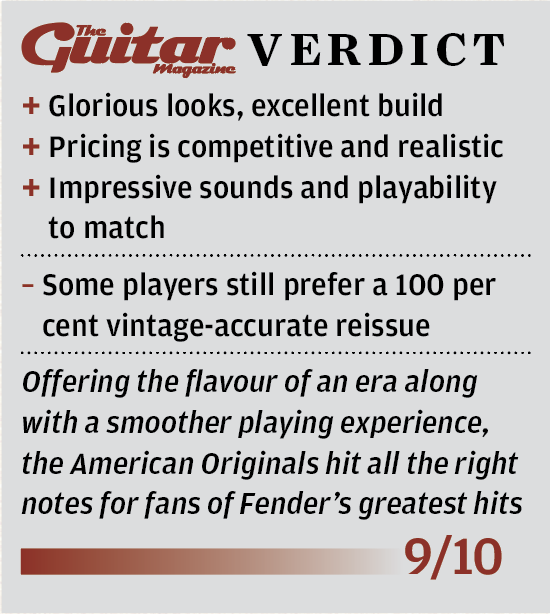Related Tags
Fender American Original ’60s Telecaster & ’50s Stratocaster Review
The American Original Series breaks with recent tradition and offers best-of-the-decade features rather than replicating specific model years. We gets our hands on the ’50s Stratocaster and ’60s Telecaster for a UK-exclusive first review…
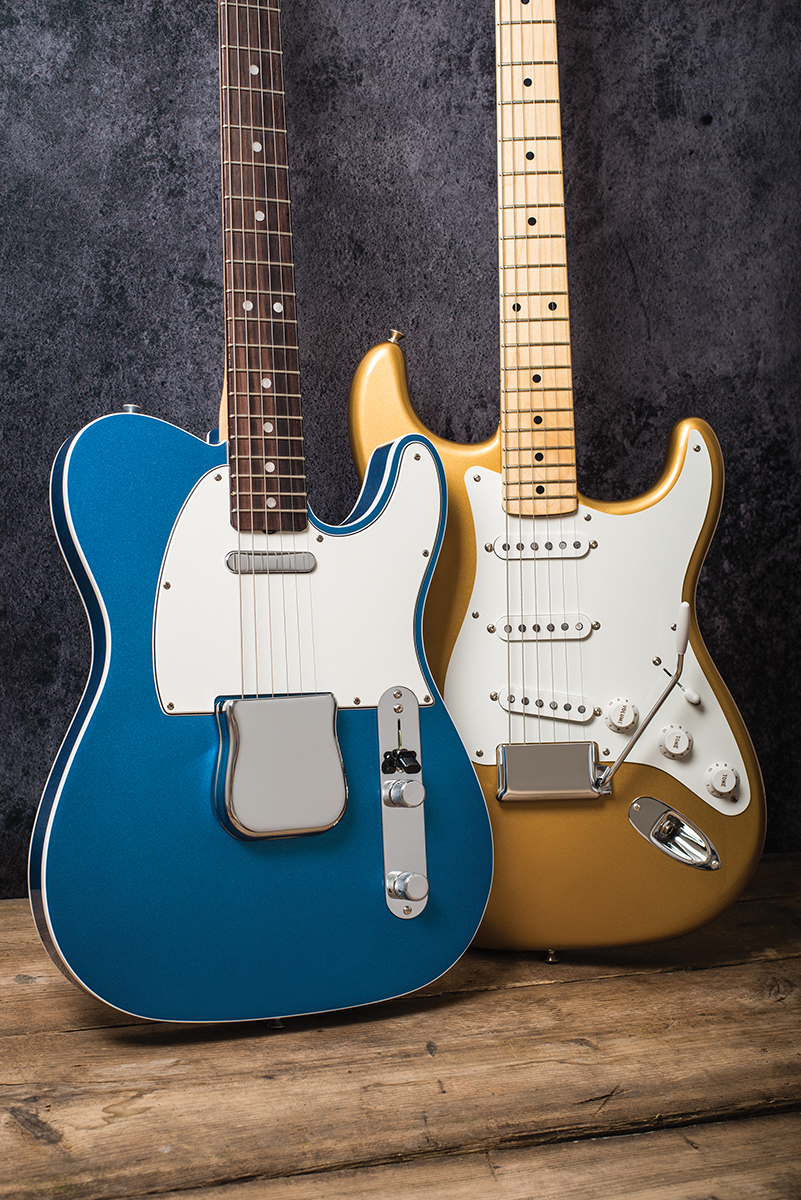
The American Vintage Series was a sweet spot for Fender. Priced just about within reach of mere mortals, with classic stylings, dimensions and nitrocellulose finishes – if you couldn’t stretch to Custom Shop money then American Vintage was where it was at for a pro-quality USA Fender with a golden era look and feel.
2012 saw American Vintage get it last major overhaul, and the focus was on making ’em like they used to, with every curve, radius and neck profile reworked to bring the models closer than ever to the guitars that came out of Fullerton in the 15-or-so-year period during which it seemed that the company could almost do no wrong.
Wind the tape forward to 2018 and American Vintage is dead… long live American Original. Occupying the same position in the catalogue and with broadly similar pricing (happily some models are even cheaper than their 2017 American Vintage equivalents), instead of zeroing in on a specific year of manufacture, the American Original Series cherry picks features from across a chosen decade and adds subtle but player-friendly updates such as 9.5-inch fingerboard radii and vintage-tall fretwire.
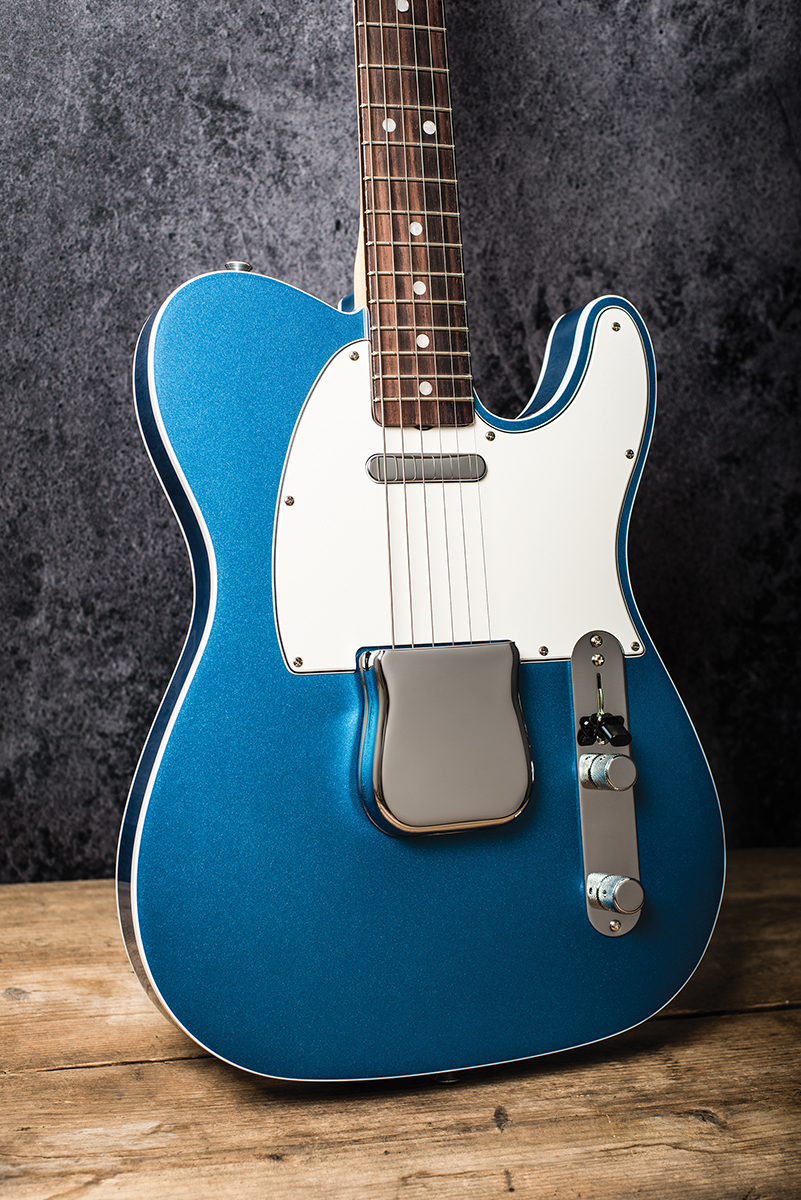
Although there are players out there for whom a 7.25-inch fretboard radius and an action with some fight is an essential part of the Fender experience, let’s leave machismo at the door along with our 0.013-gauge strings for a moment – a 9.5-inch ’board radius almost certainly has broader appeal without the playing surface being so flat that it no longer feels like a Fender.
Justin Norvell (Senior Vice President, Fender Products) reveals that this change was in direct response to feedback from players: “Although 7.25 inches is ‘vintage correct’, that spec is of an era of wound G strings, really heavy gauges and not much string bending. People just play differently now. We felt strongly (and got a lot of feedback) about making these instruments more playable or ‘fight back’ less. This again comes back to our goal – looking to make great instruments to play, rather than making things the old way ‘just because’.”
When you count up the various finish and neck permutations plus lefties (of which there are two Strats and a Tele to choose from) and basses, there are 30 different flavours of American Original spanning three decades. We’ll be taking a look at the offsets and basses in a future issue but we’re kicking things off with the ’50s Stratocaster in Aztec Gold and the double-bound Lake Placid Blue ’60s Telecaster. Think of each instrument more as a ‘best of’ compilation album that combines the most popular features from a given decade but dispenses with the experimental sound collage on side four that everyone skips over anyway.

With Relics now so commonplace there’s undeniably something a little ‘new shoes’ about strapping on such pristine instruments, but the nitrocellulose paint-jobs (with a thin poly base coat for consistency) will soon begin to wear in the old-fashioned way, although the finishes appear to be a little more chip-resistant than the ‘flash coat’ lacquer on the 2012 models. And what finishes – the vivid Lake Placid Blue and Aztec Gold metallics practically jump out of the guitar cases and play the gig themselves.
Each guitar’s Pure Vintage pickup set is carried over from the American Vintage Series, with the Strat equipped with a trio of ’59s and the Tele a pair of ’64 units. “The work we did on the American Vintage Series involved deep tonal blueprinting of the right tones and materials, so there was nothing to improve there,” says Norvell. “The choice was more, ‘which set do we choose?’ Keeping the pickups with that 100 per cent vintage sound is a big part of what these are. We were careful with the things that keep the instrument ‘true’ – neck shapes, the lacquer finish and the pickups.”
The neck profiles here – a Soft V shape in the case of the Strat and a mid-60s C for the Tele �– are also derived from analysis of vintage instruments. “We were able to find great examples of each era and nail the dimensions and feel,” Norvell reveals. “The interesting thing about the vintage era is how different several examples could be, since they were all hand-cut and sanded all the way through – so there are okay ones, good ones, and great ones. The great thing about modern CNC technology is that we can make the ‘great ones’ extremely repeatable within very tight tolerances.”

The bodies are nicely svelte. Both guitars are in that happy weight zone between seven and eight pounds, while the Strat’s plunging contours are as comfortable today as they were 64 years ago and will still be 64 years hence. Alder bodies arrived in mid-1956 on Sunburst Stratocasters but blonde models retained ash – our review model’s body is alder, but should you want the ash-bodied ’50s Stratocaster experience then the White Blonde model is your go-to.
The double-bound Telecaster has similarly pleasing lines that tie-in with a general mid-60s vibe. The rosewood fingerboard features the larger pearloid dots that superseded clay position markers in early ’65, but the headstock logo is of the earlier spaghetti type that lasted until the fall of ’64. There’s no exaggerated router hump in the cutaway and in any case, router humps had all but vanished by 1964 and are barely perceptible even on the earliest double-bound Custom Telecasters from 1959. Time to climb back out of the rabbit hole and plug in…

In Use
For roots rock, 60s pop and R&B-inspired players who know how to use a low-to-medium-powered tweed amp, the Telecaster’s combination of cut and punch is manna from heaven. Dave Davies, early Page, The Who, Fleetwood Mac, Petty, the Stones – it’s all here and it doesn’t take much effort to find it.
Again we’re reminded that the common misconception about Telecasters sounding thin is exactly that – there’s a ton of bass available here, but the snap of the steel saddles helps ensure that even the much-maligned Tele neck pickup never sounds too woolly unless you force the issue with extreme tone control roll-off.
Compared directly to a 50s-style Tele with a swamp ash body, maple board, brass saddles and a flat-pole Broadcaster-style bridge pickup, the ash guitar has more growl, more midrange and more push but the American Original has more sparkle and twang and absolutely draws you towards the 1960s in terms of sonics and playing vocabulary.
Like its American Vintage predecessors of 2012, the ’60s Telecaster’s neck profile is no generic, overly-slim caricature of a C-shaped neck of the period. With a healthy 24.7mm depth at the 12th fret, the neck fills out in a pleasingly authentic manner but never feels like too much of a handful – and it will only get better with age.
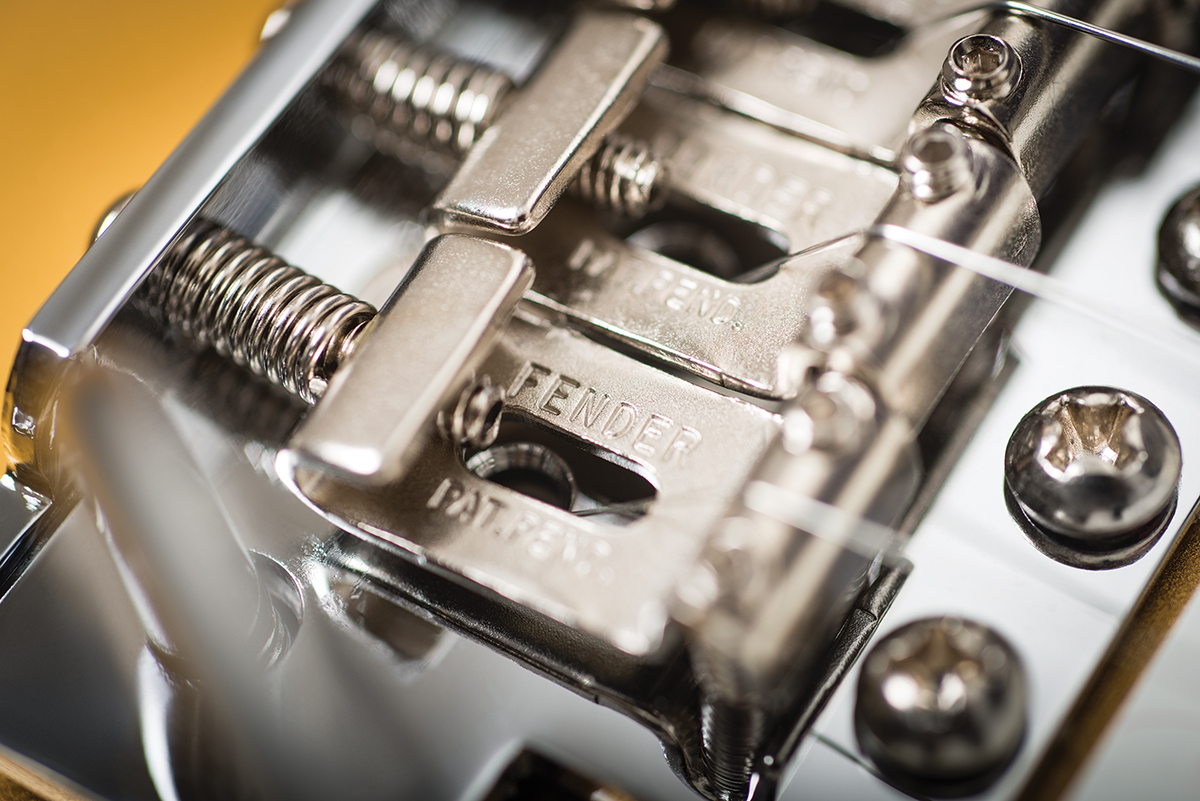
Switching over the American Original Stratocaster, there’s no denying that the gloss nitro-finished maple board has a little more drag than the Telecaster’s unfinished rosewood. It takes a little getting used to but the fretboard edges have been nicely broken before spraying and once again, the sheer ergonomics and comfort of this design – especially dressed in such a wonderfully rich metallic hue – remind us how jarringly futuristic this instrument must have seemed to players back in the 1950s.
With a five-way switch and a rear tone control that rolls off highs on the bridge pickup as well as the middle, it’s just about perfect. With the tone controls wide open the sounds are Stratocaster in excelsis, especially in positions two and four. Having a tone control on the bridge pickup is a real boon with overdrive – nowadays it’s such a common mod, but if you haven’t used a Strat with this wiring before, try knocking the tone back on the bridge pickup into gain. It offers much smoother and more pleasant lead sounds, tames any scratchiness in the high end and offers an almost P-90-like growl when playing aggressive first-position rhythm parts and riffs.
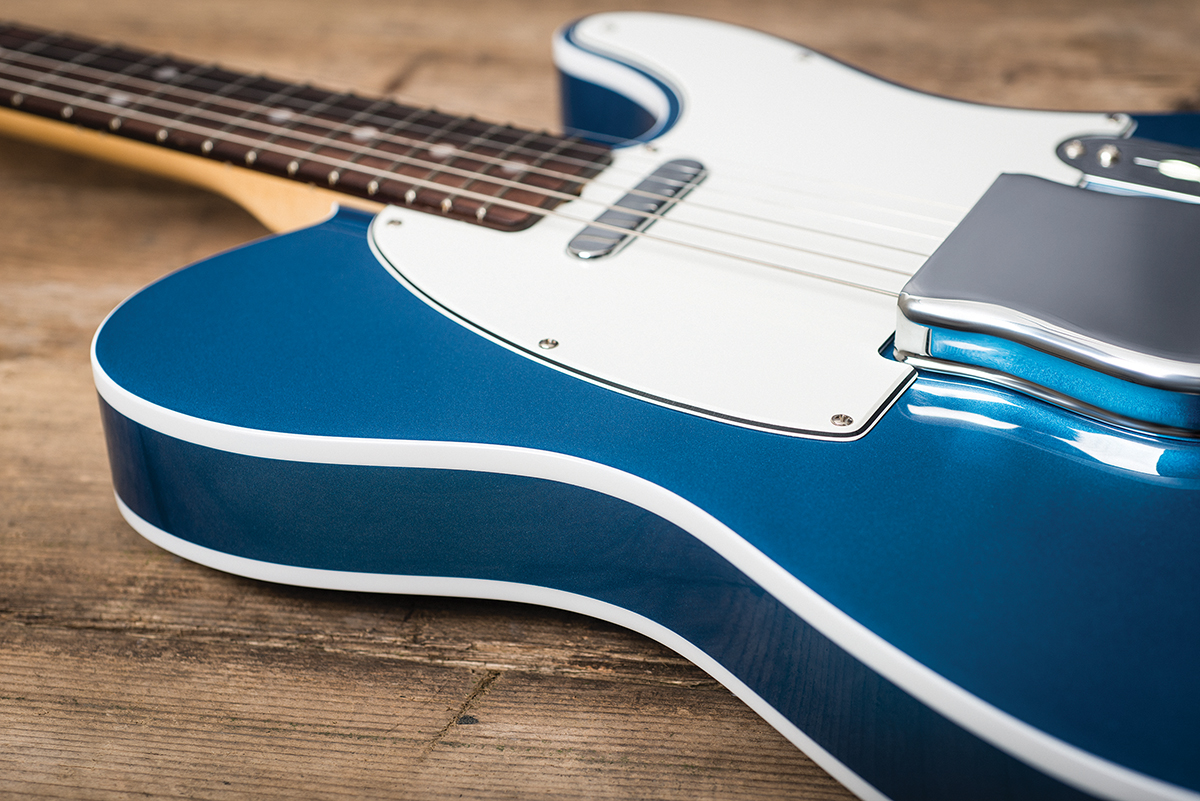
A comparison to an ash-bodied Custom Shop ’56 model proves interesting – with our amp settings unchanged, the Custom Shop guitar is more explosive and woody but the American Original has an angelic clarity. Despite the gulf in price, there’s no winner or loser as such, it’s just preference. The American Original’s Knopfler to the Custom Shop instrument’s SRV is perhaps the most apt comparison, although the review guitar’s shimmering trebles retain definition superbly into swirling effects or a heavy fuzz.
With more of a blackface-voiced amp and spring reverb, the American Original Strat’s inherent clarity leads to many lost hours simply digging into bends and letting notes hang in the air. As supplied, the set-up is excellent, with the vibrato floating smoothly and returning to pitch accurately – there’s also very little unwanted play in the arm. The neck is a delight too – though its 25.6mm depth at the 12th fret appears hefty on paper, the comfortably rounded shoulders and subtle transition from V to C mean that it doesn’t feel it. It’s a slice of luxury without the Custom Shop price to match.
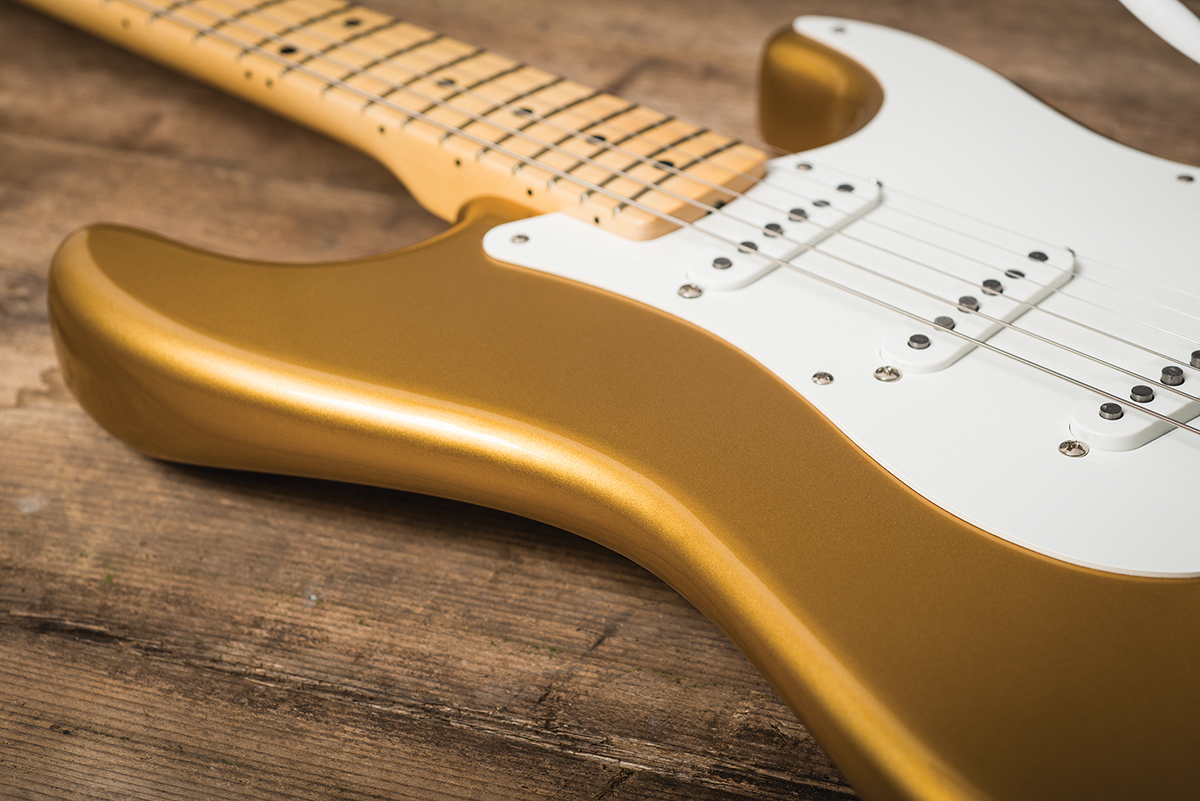
Whenever Fender reissues its classic designs, some observers will accuse the company of resting on its laurels, which ignores that fact that there’s plenty of new ground being broken elsewhere in the company’s catalogue. Like the American Vintage Series before it, American Original is about paying tribute to mid-century modern designs that still look and sound utterly contemporary.
Some players will lament any departures from vintage spec, but most – this writer included – will find the 9.5-inch fingerboard radius and vintage-tall fretwire provides a ‘best of both worlds’ solution that’s genuinely easier to play in higher registers, especially when bending strings. There might be ‘no money up there’, but there’s a whole lotta fun.
KEY FEATURES
Fender American Original ’60s Telecaster
• PRICE £1,659 (inc hard case)
• DESCRIPTION Single-cutaway solidbody electric. Made in USA
• BUILD Alder body, bolt-on maple neck with 9.5-inch radius round laminated rosewood fingerboard, ‘mid-60s C’ profile and 21 vintage-tall frets, bone nut
• HARDWARE 3-saddle Vintage Style Tele bridge with barrel steel saddles, Pure Vintage Single Line ‘Fender Deluxe’ machineheads
• ELECTRICS 2x Pure Vintage ‘64 Gray-Bottom Single-Coil Tele pickups, 3-way blade pickup selector switch, master volume, master tone
• SCALE LENGTH 25.5”/648mm
• NECK WIDTH 42.1mm at nut, 51.3mm at 12th fret
• NECK DEPTH 21.4mm at first fret, 24.7mm at 12th fret
• STRING SPACING 35.7mm at nut, 52.5mm at bridge
• WEIGHT 7.6lbs/3.4kg
• FINISH Lake Placid Blue gloss nitrocellulose (as reviewed), 3-Colour Sunburst, Fiesta Red
• LEFT-HANDERS American Original ’50s Telecaster only (£1,549)
KEY FEATURES
Fender American Original ’50s Stratocaster
• PRICE £1,609 (inc hard case)
• DESCRIPTION Double-cutaway solidbody electric. Made in USA
• BUILD Alder body, bolt-on maple neck with 9.5-inch radius fingerboard, ‘Soft V’ profile and 21 vintage-tall frets, bone nut
• HARDWARE Pure Vintage six-saddle synchronized vibrato bridge, Pure Vintage Single Line ‘Fender Deluxe’ machineheads
• ELECTRICS 3x Pure Vintage ’59 single-coil pickups, five-way blade pickup selector switch, master volume, neck tone control, bridge/middle tone control
• SCALE LENGTH 25.5”/648mm
• NECK WIDTH 42.0mm at nut, 51.0mm at 12th fret
• NECK DEPTH 23.2mm at first fret, 25.6mm at 12th fret
• STRING SPACING 35.1mm at nut, 53.6mm at bridge
• WEIGHT 7.9lbs/3.6kg
• FINISH Aztec Gold gloss nitrocellulose (as reviewed), 2-Colour Sunburst, White Blonde (ash body)
• LEFT-HANDERS Yes, White Blonde only, no upcharge
• CONTACT Fender EMEA 01342 331700, www.fender.com
